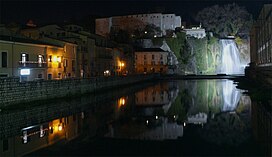Valle Latina
| Valle Latina | |
|---|---|
 Isola del Liri (FR), Valle Latina | |
| Geography | |
| Location | Italy, Lazio, Frosinone |
| Rivers | Sacco ; Liri |
Valle Latina (English: "Latin Valley") is an Italian geographical and historical region that extends from the south of Rome to Cassino,[1][2][3] corresponding to the eastern area of ancient Roman Latium.
The valley's principal cities are Frosinone, Cassino, Sora, Grottaferrata, Anagni, Alatri.
History
Ancient

According to the tradition, in 496 BC the Romans defeated their Latin rivals in the
Middle Ages and Modern era

At the end of the 5th century the Valley, along with the rest of the Peninsula, became part of the
Cultural heritage

In the Valley there are numerous small towns of great artistic and cultural importance. A quick and incomplete presentation is given here. In addition to the aforementioned Abbey of Monte Cassino, the city of Cassino preserves the remains of the ancient
A little further north, in
Gallery
References
- ^ Giuseppe Ponzi, Osservazioni geologiche fatte lungo la Valle Latina, Roma, 1849
- ^ Sabrina Pietrobono, I monasteri della Media Valle Latina (Frosinone): aspetti topografici e scelte insediative, in Letizia Ermini Pani, Committenza, scelte insediative e organizzazione patrimoniale nel Medioevo, Atti del Convegno di studio, Tergu 15-17 settembre 2006, Centro Italiano di Studi sull'Alto Medioevo, Spoleto, 2007, p. 472
- ^ Antonello Angelucci, La serie miocenica nella media Valle Latina (Frosinone), in "Geologica Romana", V, 1966
- ^ Chisholm, Hugh, ed. (1911). "Hernici". Encyclopædia Britannica (11th ed.).
- ^ Volsci, Enciclopedia Treccani
- ^ L'Italia preromana. I siti laziali: Cassino, in Il Mondo dell'Archeologia (Treccani), 2004
- ^ "Casinum", The Oxford Classical Dictionary, New York 1999
- ^ L'Italia preromana. I siti laziali: Cassino, in Il Mondo dell'Archeologia (Treccani), 2004
- ^ "Casinum", The Oxford Classical Dictionary, New York 1999
- ^ Varro, De lingua latina, VII,29
- ^ Strabo, Geographica, V, 3,9.
- ^ On the history of Monte Cassino: Herbert Bloch, Monte Cassino in the Middle Ages, Harvard University Press / Edizioni di storia e letteratura, 1986.
- ^ L. Fabiani, La terra di S. Benedetto: studio storico giuridico sull'Abbazia di Montecassino dall’VIII al XIII secolo, Badia di Montecassino, 1968, rist. anastatica, Isola del Liri
Bibliography
- Giuseppe Ponzi, Osservazioni geologiche fatte lungo la Valle Latina, Roma, 1849
- Sabrina Pietrobono, La Media Valle Latina: castelli e viabilità in una zona di frontiera, Società degli Archeologi Medievisti Italiani, 2006
- Sabrina Pietrobono, I monasteri della Media Valle Latina (Frosinone): aspetti topografici e scelte insediative, in Letizia Ermini Pani, Committenza, scelte insediative e organizzazione patrimoniale nel Medioevo, Atti del Convegno di studio, Tergu 15-17 settembre 2006, Centro Italiano di Studi sull'Alto Medioevo, Spoleto, 2007
- Italy, Volume 1, Naval Intelligence Division (of the United Kingdom), 1944, p. 292
See also






